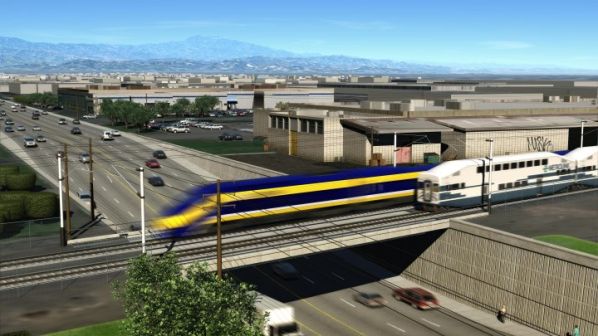THE California High-Speed Rail Authority (CHSRA) has outlined a path forward for completing construction of the Central Valley section of the California high-speed line.
The Revised Draft 2020 Business Plan, slated for final approval last year, but repeatedly delayed due to the pandemic, affirms the development of the electrified Merced - Fresno - Bakersfield high-speed rail interim service line, while advancing environmental reviews and current investments in local and regional infrastructure projects.
The plan also lays out the challenges of the pandemic, and how CHSRA is overcoming them and working to mitigate ongoing impacts.
As a result, CHSRA needs more time to complete the work, according to CHSRA CEO, Mr Brian Kelly.
Kelly reports that construction on the first 35.4km segment through Kern County is expected to reach “substantial completion” in about 15 months. Construction on a 51.5km stretch between Avenue 19 in Madera County and East American Avenue in Fresno County, and on approximately 96.5km from East American Avenue to 1.6km north of the Tulare-Kern County line, will take CHSRA into 2023. Kelly also writes that construction costs are up by about $US 330m over the current budget, and “because of the risk and uncertainty that lays ahead, we propose to increase our contingency budget considerably.”
Kelly also reports that “to mitigate risks affecting our Track and Systems procurement, we propose to change the timing, approach to construction and phasing of the track installation. These actions will mitigate cost risks and improve construction efficiency.”
The Revised Draft 2020 Business Plan recommends that $US 4.1bn in remaining bond funds, from the 2008 voter-approved Proposition 1A for high-speed rail planning and construction, be directed to complete delivery of the 191.5km Central Valley segment, and $US 100m in remaining bond funds be used for early design and completing environmental review of the Phase 1 alignment from San Francisco to Los Angeles.
The priorities outlined in the plan include:
- completing the 191.5km Central Valley construction segment and laying track “pursuant to our federal funding grant agreements with the Federal Railroad Administration (FRA)”
- expanding the Central Valley segment to 275.2km of operable electrified high-speed rail connecting Merced, Fresno and Bakersfield
- starting high-speed train testing by 2026-27 and putting trains into service by the end of 2030
- environmentally clearing all segments of the Phase 1 system between San Francisco and Los Angeles, and
- pursuing additional funding opportunities to prospectively ‘close the gaps’ and expand electrified high-speed rail service to the Bay Area and Los Angeles/Anaheim as soon as possible.
A 30-day public consultation period on the plan closes March 12. Final plan submission to the California legislature is expected by April 15.
“At a time when job growth is needed most, California high-speed rail is putting thousands to work in good paying labour jobs in the Central Valley and making tremendous progress on construction of the nation’s first high-speed rail,” says California governor, Mr Gavin Newsom. “Our goal is to get fast, electrified trains up and running in the Central Valley as soon as possible while leveraging other sources of funding to advance important, clean rail and transit work state-wide. We’re confident that our federal partners in the Biden administration share our vision for electrified rail - we look forward to working with them to get it done.”
“America has a chance to lead the world once more through innovation in infrastructure - connecting our communities, creating good jobs, addressing climate change and ensuring equity,” acting FRA administrator, Mr Amit Bose, said in a statement following the release of the plan. “Passenger rail development, including world-class high-speed rail, can and must be a part of our strategy to accomplish these goals. As in many other arenas, California has taken the lead nationally to advance high-speed rail, starting an economically transformative project in the Central Valley and assuming the challenges that come with that leadership. The US Department of Transportation looks forward to partnering with California as it leads the way to build back better.”
High Speed Funding
According to CHSRA, the California Administration “has communicated with the federal government on the need for flexibility on the American Recovery and Reinvestment Act (ARRA) grant agreement timelines and emphasised the importance of settling existing litigation to restore nearly $US 1bn in grant funding de-obligated by the Trump Administration.”
This comes after former president, Mr Donald Trump, withdrew the funding in May 2019.
CHSRA has two funding agreements with FRA, totalling approximately $US 3.5bn: ARRA and FY10. “These funds have been at risk since the FRA’s May 2019 letter terminating the FY10 grant agreement [of $US 929m],” the plan noted. FRA took “the position that the project had failed to make steady progress,” according to the plan. The State of California subsequently filed a legal suit to stop the action.
The $US 2.5bn in ARRA funding was fully expended before the statutory deadline and in compliance with the FRA grant requirement, the plan says. “Having spent the federal funds, the Authority is now required to match those funds by the grant deadline of December 2022,” the plan noted. “We are nearing completion of that match - currently shown at 99.5% as of November 30 2020. We expect to attain the full match required for this grant by March 2021, 22 months ahead of the deadline.
“Per the terms of the federal grant agreement, the FY10 funds, along with $US 360m of state matching funds, are scheduled to be the last funding required to complete the federal grant scope of work.”
CHSRA has also secured funds from two state sources: Proposition 1A bond funds and Cap-and-Trade funds.
The approved Proposition 1A provided $US 9.95bn for high-speed rail planning and construction. Of this, $US 9bn was allocated to CHSRA and $US 950m was allocated to local high-speed rail connectivity projects under the oversight of the California Transportation Commission.
For detailed data on high-speed projects around the world, subscribe to IRJ Pro.

